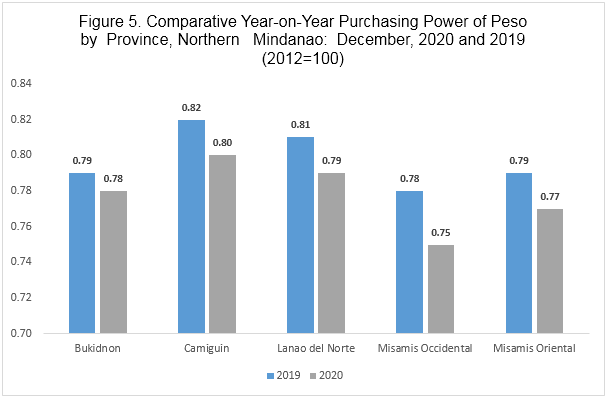The price of a basket of goods in December 2020 is higher than its price in 2012 by 29.2 percent
The Consumer Price Index (CPI) in Northern Mindanao for the month of December 2020 registered at 129.2 which implies that the price of a basket of goods in December 2020 was 29.2 percent higher than its price in 2012. The CPI is an indicator of the change in the average retail prices of a fixed basket of goods and services commonly purchased by households relative to a base . (Figure 1)
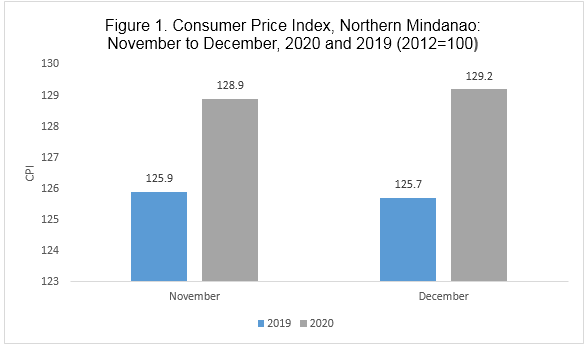
Among the commodity groups, Alcoholic Beverages and Tobacco posted the highest CPI in December 2020 at 246.0, followed by Housing, Water, Electricity, Gas, and Other Fuels at 143.9, and Health at 134.8. On the other hand, Recreation and Culture at 114.1, Transport at 113.4, and Communication at 106.5 were the three commodity groups with the lowest CPI recorded in the month of December 2020. (See Figure 2)
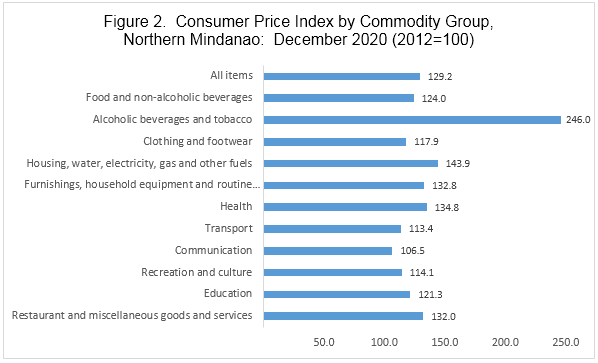
INFLATION RATE
Regional inflation increased at 2.8 percent in December 2020
Regional inflation in December 2020 accelerated at 2.8 percent compared to the 1.4 percent inflation rate in the same period of the previous year. The higher inflation rate in December 2020 implies that prices in December 2020 increased at a faster pace compared to the prices in December 2019. (Figure 3)
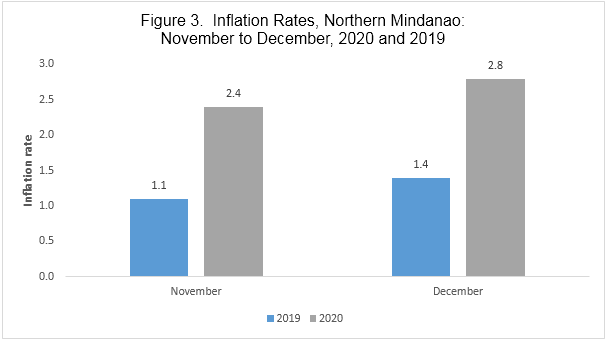
Misamis Occidental posted the highest inflation rate of 4.5 percent year-on-year
In terms of inflation rate, Misamis Occidental registered the highest inflation rate of 4.5 percent in December 2020. Bukidnon, on the other hand, posted the lowest inflation rate of 2.1 percent.
All provinces registered higher inflation rates in December 2020 as compared to the same month a year ago. This means that, in all provinces of Northern Mindanao, prices in December 2020 increased at a faster rate than prices in December 2019. (Figure 4)
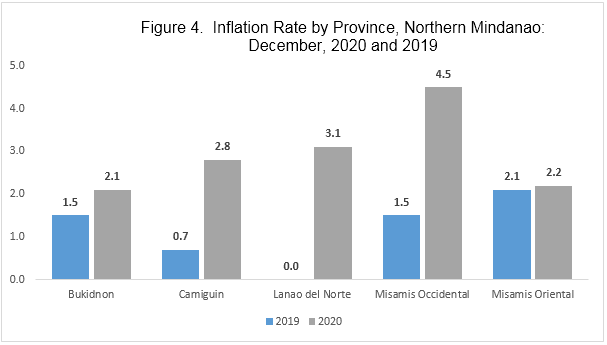
PURCHASING POWER OF PESO (PPP)
The Purchasing Power of Peso (PPP) shows the real value of the peso relative to the base period. The PPP in Northern Mindanao was posted at PhP 0.77 in December 2020. This means that a consumer’s PhP 100 in 2012 can only purchase PhP 77 worth of goods and services in December 2020. (Figure 5)
All provinces showed a lower PPP in December 2020 compared to December 2019. Misamis Occidental posted the highest decline of 0.03 pesos while Bukidnon posted the lowest decline of 0.01 pesos.
JANITH C. AVES
(Chief Statistical Specialist)
Officer-in-Charge
SSB/JTS
For further inquiries, you may contact:
Statistical Operations and Coordination Division
Philippine Statistics Authority - Regional Statistical Services Office 10
3F Limketkai Module 2 BPO & Cyberpark Building
Rosario Crescent, Lapasan, Cagayan de Oro City
TECHNICAL NOTES
Consumer Price Index (CPI) – The CPI is an indicator of the changes in the average retail prices of a fixed basket of goods and services commonly purchased by households relative to a base year.
Used of CPI – CPI is most widely used in the calculation of the inflation rate and purchasing power of peso. It is a major statistical series used for economic analysis and as a monitoring indicator of government economic policy.
Computation of CPI – The computation of the CPI involves consideration of the following important points:
- Base Period – The reference data or base period is the benchmark or reference date or period at which the index is taken as equal to100.
- Market Basket – A sample of the thousands of varieties of goods purchased for consumption and services availed by the households in the country selected to represent the composite price behavior of all goods and services purchased by consumers.
- Weighing System – The weighing pattern uses the expenditures on various consumer items purchased by households as a proportion to total expenditure.
- Formula – The formula used in computing the CPI is the weighted arithmetic mean of price relatives, the Laspeyre’s formula with a fixed base year period (2012) weights.
- Geographic Coverage – CPI values are computed at the national, regional, and provincial levels, and for selected cities.
Inflation Rate (IR) – is the rate of change of the CPI expressed in percent. Inflation is interpreted in terms of declining purchasing power of peso.
Purchasing Power of Peso (PPP) – shows how much the peso in the base period is worth in the current period. It is computed as the reciprocal of the CPI for the period under review multiplied by 100.




